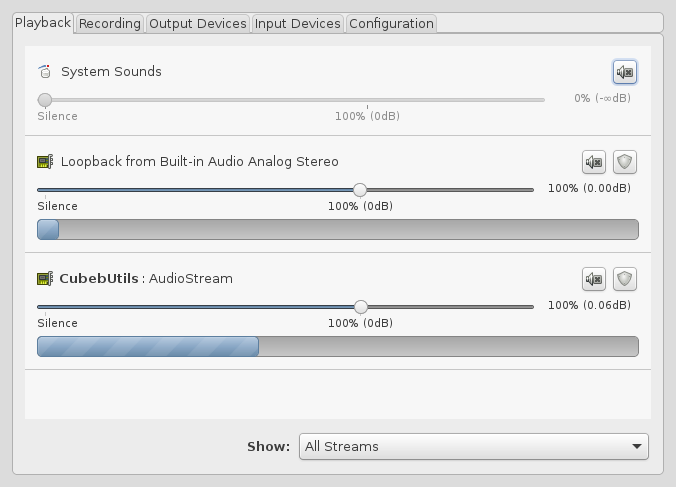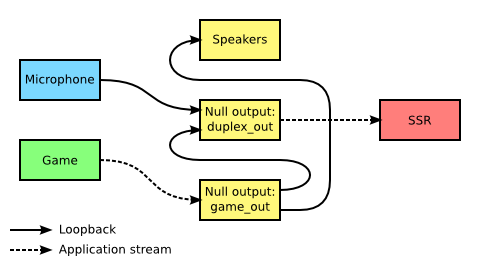

- #Audio loopback pulseaudio how to#
- #Audio loopback pulseaudio code#
- #Audio loopback pulseaudio windows#
It took an unnecessarily long time to figure out the code path for audio playback and recording, simply because there is no document anywhere that details the sequence of events needed to get there. It could go into more detail with regards to edge cases and error conditions But it truly lacks high-level overviews and examples. The API documentation is fine, as far as it goes.

What is difficult however, is the documentation. This procedure is cumbersome, but not difficult. After that, clean up by decrementing a reference count. Every function call has to lock the main loop, and block while waiting for the callback to be called. With such a mind set, there is a certain impedance mismatch to overcome when using PulseAudio. Python is old-school in that it still thinks that concurrency is better solved with multiple, communicating processes, than with shared-memory threads. For PythonAudio, I wrapped this structure in regular Python functions that wait for the callback and return its data as normal return values.ĭoing this shows just how old Python really is. While this may be a good structure for high-performance multithreaded C-code, it is somewhat cumbersome in Python. Most PulseAudio functions are asynchronous: Function calls return immediately, and call user-provided callback functions when they are ready to return results. From a high level, this is all there is to it. The context can also create a stream that can be read or written (aka recorded or played). While the mainloop is running, you can query the context for sources and sinks (aka microphones and speakers). It all starts with a mainloop and an associated context. Still, the API itself is relatively simple, and compactly defined in one simple header file. For the purposes of PythonAudio however, I had to look at the more in-depth asynchronous API. It provides several levels of abstraction, the highest of which takes only a handful of lines of C to get audio playing. The very nice thing about PulseAudio is that it is a native C API. Under the hood, PulseAudio uses ALSA for its actual audio input/output, but presents the user and applications with a much nicer API and UI. There is the grandfather OSS, the more modern ALSA, the more pro-focused JACK, and the user-focused PulseAudio. PulseAudio is not the only audio API on Linux. To avoid confusion with the macOS API of the same name, I will always to refer to it as WASAPI.
#Audio loopback pulseaudio windows#
: WASAPI is part of the Windows Core Audio APIs. All available sound cards should be listable and selectable, with correct detection of the system default sound cards (a feature that is very unreliable in PortAudio). For reference, the singular use case in PythonAudio is block-wise playing/recording of float data at arbitrary sampling rates and block sizes.
#Audio loopback pulseaudio how to#
This series of blog posts summarizes my experiences with these three APIs and outlines the basic structure of how to use them.

This effort resulted in PythonAudio, a new pure-Python package that uses CFFI to talk to PulseAudio on Linux, Core Audio on macOS, and WASAPI on Windows. Instead of relying on PortAudio, I would have to use the native audio APIs of the three major platforms directly, and implement a simple, cross-platform, high-level, NumPy-aware Python API myself.

However, I then realized that PortAudio itself had some inherent problems that a wrapper would not be able to solve, and a truly great solution would need to do it the hard way: Thus, I set out to write PySoundCard, which is a higher-level wrapper for PortAudio that tries to be more pythonic and uses NumPy arrays instead of untyped bytes buffers for audio data. However, I soon realized that PyAudio mirrors PortAudio a bit too closely for comfort. My first step to improve this situation was a small contribution to PyAudio, a CPython extension that exposes the C library PortAudio to Python. It has long been a major frustration for my work that Python does not have a great package for playing and recording audio. This second part is about PulseAudio on Linux. This is part two of a three-part series on the native audio APIs for Windows, Linux, and macOS.


 0 kommentar(er)
0 kommentar(er)
